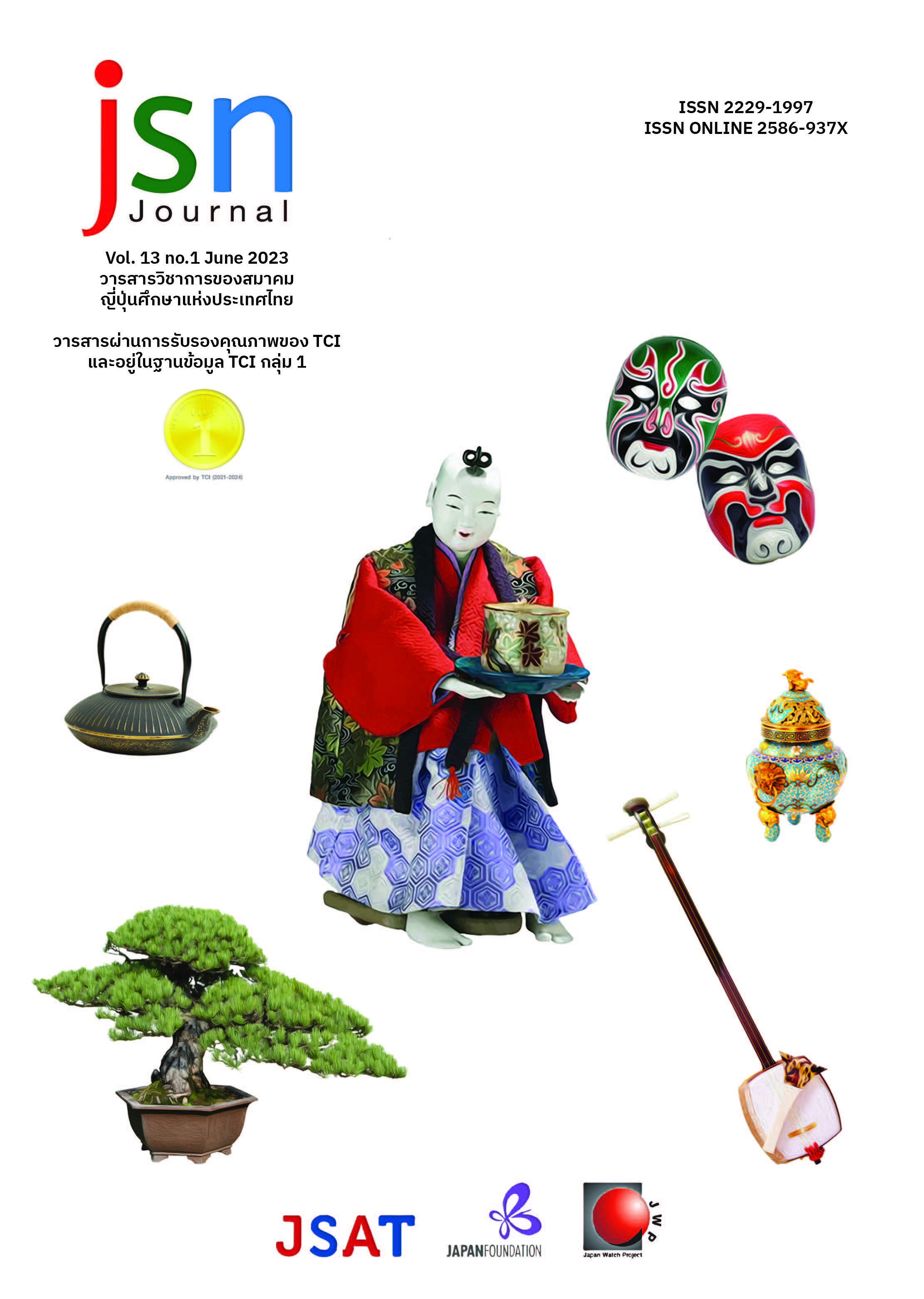A Comparative Study of the Thai Auxiliary Verb Dây and its Japanese Equivalent in Translated Novels
Main Article Content
Abstract
This research aims to study the relationship between the auxiliary verb dây, expressing the meaning of modality, and its Japanese translations. The data were collected from Japanese novels and translations and Thai novels and translations. The results reveal that the auxiliary verb dây expresses the meaning of modality divided by structures and meanings into five categories: 1) ability/capability/capacity; 2) probability; 3) possibility; 4) permissibility; and 5) desire/demand. The results of comparing the Japanese translations reveal that over 95% of the translations of “ability/capability/capacity” and “probability” are non-modality expressions. In contrast, over 70% of the Japanese translations of “possibility” and “desire/demand” are modality expressions. However, there was one structure for which the Japanese translations showed an equal proportion of modality expressions and non-modality expressions: “permissibility.” The overall results indicate that the Japanese translations tend to be non-modality expressions at more than 90%. These differences are relevant to the wide use of intransitive verbs in Japanese.
Article Details

This work is licensed under a Creative Commons Attribution-NonCommercial-NoDerivatives 4.0 International License.
ข้อความและข้อคิดเห็นต่างๆ ในบทความเป็นของผู้เขียนบทความนั้นๆ ไม่ใช่ความเห็นของกองบรรณาธิการหรือของวารสาร jsn Journal
References
กนกวรรณ เลาหบูรณะกิจ คะตะกิริ. (2565). มองภาษาญี่ปุ่นผ่านการเปรียบต่าง. กรุงเทพฯ: โครงการเผยแพร่ผลงานวิชาการ คณะอักษรศาสตร์ จุฬาลงกรณ์มหาวิทยาลัย.
ปรัชญาภรณ์ รัตนพงศ์ภิญโญ. (2562). การศึกษารูปประโยคだろう Daroo ในภาษาญี่ปุ่นกับสำนวนแปลในภาษาไทย กรณีศึกษาจากงานวรรณกรรม และบทสนทนาในละครโทรทัศน์. Veridian E-Journal, Silpakorn University (Humanities, Social Sciences, and arts), 12(6), 2459-2475. สืบค้นจาก https://he02.tci-thaijo.org/index.php/Veridian-E-Journal/article/view/201873/161494
ราชบัณฑิตยสถาน. (2556). พจนานุกรมไทยฉบับราชบัณฑิตยสถาน พ.ศ.2554 : เฉลิมพระเกียรติพระบาทสมเด็จพระเจ้าอยู่หัว เนื่องในโอกาสพระราชพิธีมหามงคลเฉลิมพระชนมพรรษา 7 รอบ 5 ธันวาคม 2554. กรุงเทพฯ: ราชบัณฑิตยสถาน. สืบค้นจาก https://dictionary.orst.go.th/
อุปกิตศิลปสาร. (2548). หลักภาษาไทย: อักขรวิธี วจีวิภาค วากยสัมพันธ์ ฉันทลักษณ์ (พิมพ์ครั้งที่ 13). กรุงเทพฯ: ไทยวัฒนาพานิช.
Iwasaki, S., & Ingkaphirom, P. (2009). A reference grammar of Thai. Cambridge: Cambridge University Press.
Palmer, F. R. (2001). Mood and modality (2nd ed.). Cambridge: Cambridge University Press.
Takahashi, K., & Methapisit, T. (2004). Observations on form and meaning of dây. In Burusphat, S. (Ed.), Papers from the 11th Annual Meeting of the Southeast Asian Linguistics Society 2001 (2004), (pp. 701-719). Arizona: Arizona State University.
Uehara, S. (2012). The cognitive theory of subjectivity in a cross-linguistic perspective: Zero 1st person pronouns in English, Thai and Japanese. In T. Miyamoto, N. Ono, K. Thepkanjana, & S. Uehara (Eds.), Typological studies on languages in Thailand and Japan (pp. 119-136). Tokyo: Hituzi Syobo.
Sirimachan, S. (2013).『「もらう」と「~てもらう」の意味・用法―それに対応するタイ語表現の考察―』東京 : 絢文社.
Sujiwarodom, S. (2009).「受動受益的『~テモラウ』文とそれに対応するタイ語の表現」『国際交流基金バンコク日本文化センター日本語教育紀要』 6, 11-22.
高梨信乃 (2010).『評価のモダリティ―現代日本語における記述的研究―』東京 : くろしお出版.
高見澤孟・ハント蔭山裕子・池田悠子・伊藤博文・宇佐美まゆみ・西川寿美 (2004).『新・はじめての日本語教育1 日本語教育の基礎知識』東京 : アスク.
田中寛 (2004). 『統語構造を中心とした日本語とタイ語の対照研究』東京 : ひつじ書房.
陳琳俊 (2019).「日本語の『Vてもいい』の意味について」『名古屋大学人文学研究論』2, 165-176.
日本語記述文法研究会 (2003).『現代日本語文法4 : 第8部モダリティ』東京 : くろしお出版.
日本語記述文法研究会 (2009). 『現代日本語文法2 : 第3部格と構文 第4部ヴォイス』東京 : くろしお出版.


